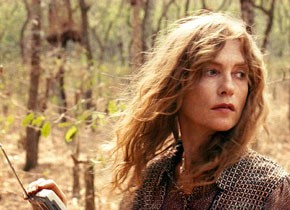Acteur: Auteur
Eight Screen Performers
April 14 to May 11, 2011
Films with Vladimir Fogel, Henry Fonda, Isabelle Huppert, Peter Lorre, Nick Nolte, Barbara Stanwyck, Tanaka Kinuyo, Lili Taylor
“Actors are our emotional government – they aren’t elected, but they wind up representing us whether we like it or not.” (Melissa Holbrook Pierson & Luc Sante)
In the public discourse on film, actors are among the most cherished of all personalities – not just in the tabloids, but also in the elevated environment of film criticism. However, they are never considered as authors of the films in which they appear. The role of the author – the name and signature responsible for the overall content and shape of a film – has, since the triumph of the French-American politique des auteurs in the 1960s, been firmly granted to the directors.
In today’s "grown-up," "reflective" view of narrative cinema, the joint activity of story development plus mise-en-scène plus final cut figures as the ultimate and only “real” form of cinematic authorship. Museums, festivals and critics have largely depended on this view in order to legitimize film as an art form: the model of director-as-author follows those of the painter, composer, and poet in the classical arts. But there exists also the "childlike," "naive" view – the view of those who are primarily interested in (and identify with) film actors and their onscreen creations. These hybrid characters, born of verisimilitude and imagination, constructed from both real and fictional components, appear to the unbiased, "uneducated" viewer as those who actually bring forth the action: as the originators of a film.
Centering on eight screen actors and actresses from various historical contexts, the series Acteur: Auteur is a playful attempt at examining this theme. Its intention is not to replace the director’s authorship with that of the actor’s, but rather to refocus on the multitude of creative forces at work in the production of feature films. Actors, like directors, do not put their "true selves" on-screen, but, like directors, create from film to film and from role to role, a more or less coherent "text" which lives in the public imagination, with both references to the past and expectations for the future. From the various characters they play (and from our knowledge of their respective real lives) arises a different kind of figure: an entity named "Isabelle Huppert" or "Peter Lorre," in which author and oeuvre can no longer be clearly separated from each other.
Huppert and Lorre (who was honored by the Film Museum in 2004 with a book and retrospective) are two of the eight artists presented here as examples of "performative" film authorship. With some, the selected works describe an arc from early to late roles. The self-contained, acerbic, non-conformist character as "written” by Barbara Stanwyck persists through all genres and decades (and was credited by some critics to Stanwyck's own "tough upbringing") – a worldly woman, named Baby Face or The Lady Eve, who invariably evokes the impression that she has fought her way up from the streets. In the case of Nick Nolte, the "text" is a specific mixture of disillusioned hippiedom and male psychopathology, and it is recognizable not only in his most iconic film (Affliction, 1997), but already at the start of his career (Who'll Stop the Rain, 1978).
For some performer-authors the window of time in which they were able to articulate their "own story" was extremely brief: the damaged, wistful, runaway-pride with which Lili Taylor graced American film only bloomed for a short period (1991-1996). And Vladimir Fogel, who in the first years of Soviet cinema projected the utopia of a newly modern human body with his rhythmically and gesturally explosive acting, burned out as quickly as he arrived (and thus solidified the later comparison with James Dean): on June 8, 1929, he took his own life at the age of 27.
In two other cases, the compression of time results only from the films selected: the long and prolific career of Henry Fonda is here focused on a few years around World War 2 when his “figure” seemed to be drawn from an infinite number of possibilities (and Hollywood even suggested him for the lead role in De Sica's Bicycle Thief). The great Japanese actress Tanaka Kinuyo is seen in three masterpieces directed by Mizoguchi Kenji. With few exceptions, Tanaka starred in all of Mizoguchi's films between 1945 and 1954, but her individual style (wandering gait, restless gestures, little eye contact, ambiguous facial expressions) extends much further back in time. The close working relationship came to an end when Mizoguchi openly – and unsuccesfully – tried to stop Tanaka's "promotion" to director. Against this background, the question of acteur as auteur becomes even more pointed: how to read Mizoguchi's canonical postwar work, when considered as the result of multiple authorship? What if the actress was not just "formed" by the director, but contributed a formative force of her own?
The selected works – three films per actor/actress – are signed by the following directors: Boris Barnet, Claude Chabrol, Claire Denis, Abel Ferrara, Robert Florey, John Ford, Nick Gomez, Alfred E. Green, Fritz Lang, Peter Lorre, Terrence Malick, Mizoguchi Kenji, Maurice Pialat, Otto Preminger, Vsevolod Pudovkin, Karel Reisz, Abram Room, Nancy Savoca, Paul Schrader, Douglas Sirk and Preston Sturges.
The opening night of the series – "White Material" starring Isabelle Huppert – is part of the Festival du film francophone. With thanks to the Institut Français de Vienne.
